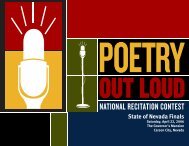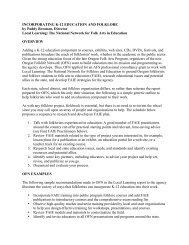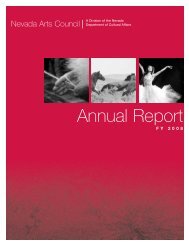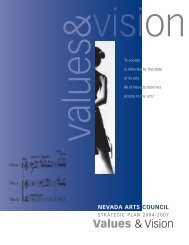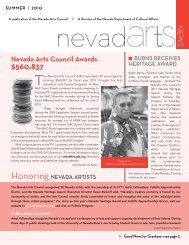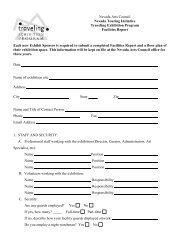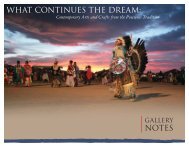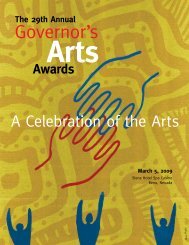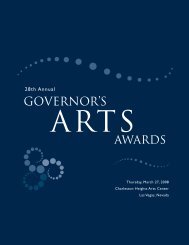Public Art - Nevada Arts Council
Public Art - Nevada Arts Council
Public Art - Nevada Arts Council
You also want an ePaper? Increase the reach of your titles
YUMPU automatically turns print PDFs into web optimized ePapers that Google loves.
4 | Monograph | March 2004<br />
Funding and Growth of <strong>Public</strong> <strong>Art</strong> Programs<br />
The amount of public art in the United States<br />
has grown over the past decade, fueled largely<br />
by the growth of commissioning programs run<br />
by city, county, and state governments. The<br />
average budget of the nation’s public art<br />
programs grew 27.4 percent to $779,968 during<br />
2001. In fact, the average public art budget<br />
nearly doubled between 1998 and 2001,<br />
increasing an average of 23.5 percent annually.<br />
In comparison, the total operating budgets of<br />
the umbrella organizations that operate public<br />
art programs grew an average of only 8.6 percent<br />
annually during the same period. Estimated<br />
spending on public art in 2003 is $150 million.<br />
Most public art programs are funded by a<br />
“percent-for-art” strategy—first used in<br />
Philadelphia in 1959—in which a small<br />
portion of capital improvement funds are<br />
allocated for acquiring or commissioning<br />
artwork. Beyond the typical “percent-for-art”<br />
model, there are a variety of funding<br />
mechanisms employed to support public art.<br />
These include annual appropriation,<br />
departmental allocation, hotel/motel tax,<br />
sales tax, tax increment financing, development<br />
fees, foundation grants or private gifts,<br />
corporate sponsorship, benefit auctions, and<br />
fundraising events. Monuments and memorials<br />
are usually funded through a combination of<br />
public and private sources.<br />
Most federally funded public art is handled<br />
through the General Services Administration.<br />
The National Endowment for the <strong>Art</strong>s’ <strong>Art</strong> in<br />
<strong>Public</strong> Places Program began in the mid-1970s<br />
and continued for over two decades. The<br />
nationwide CETA (Comprehensive Employment<br />
Training Act) program of the late 1970s put<br />
hundreds of artists to work in their<br />
communities, on a scale similar to the WPA<br />
programs of the 1930s. Today we see federal<br />
support for public art through such programs<br />
as the U.S. Department of Transportation’s<br />
Transportation Equity Act of the 21st Century<br />
(TEA-21) and <strong>Art</strong> & Community Landscapes,<br />
a partnership of the National Park Service,<br />
the New England Foundation for the <strong>Art</strong>s, and<br />
the NEA. <strong>Public</strong> art initiatives can also be found<br />
within state departments of transportation,<br />
neighborhood revitalization programs, and<br />
community development corporations.<br />
Revenue Sources: Government Programs<br />
Revenue Sources: Private Programs<br />
28% Earned<br />
2% Earned<br />
7% Private<br />
29% Private<br />
43% Government<br />
91% Government<br />
www.AmericansForThe<strong>Art</strong>s.org



